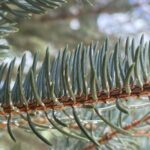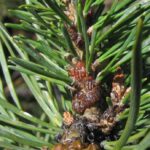Pine Needle Scale
Leaf Feeding Insects & Mites
Pine Needle Scale (Chionaspis pinifoliae) is a type of scale insect that infests pine trees. This insect is found throughout North America, including Canada and the United States, and is considered a serious pest of pine trees in forests, parks, and residential areas.
The Pine Needle Scale is a small, round, armored insect that ranges in color from yellow to brown. The female scale is generally larger than the male and can reach up to 2 mm in length. The insect feeds on the sap of pine trees and inserts its straw-like mouthparts into the needles to feed. As it feeds, it can cause needle yellowing, needle drop, and stunted growth. In severe infestations, the insect can kill the tree.
The Pine Needle Scale is most active from spring to fall and overwinters as an egg or juvenile stage within the protective cover of the scale. The female insect lays up to 500 eggs, which hatch into tiny crawlers that spread out to infest new needles. The insect is difficult to control because it is protected by a hard, waxy covering that makes it resistant to insecticides.
Pine Needle Scale can be controlled through a combination of physical, chemical, and biological control methods. Physical control methods include removing and destroying infested needles, which can help to reduce the overall population of the insect. Chemical control methods include using insecticides, such as horticultural oil or imidacloprid, which are applied to the tree to kill the insect. Biological control methods include using natural enemies, such as parasitic wasps or ladybugs, to feed on the insect and control its population.
It is important to monitor pine trees regularly for signs of Pine Needle Scale infestation, and to take action quickly if an infestation is discovered. Prompt treatment can help to prevent serious damage to the tree and preserve its health and appearance.



